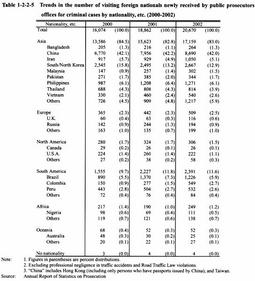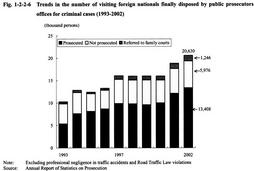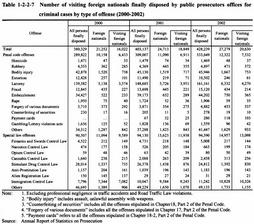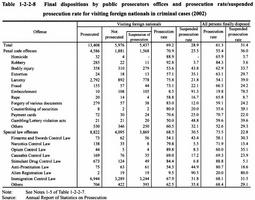| Previous Next Index Image Index Year Selection | |
|
|
3 Treatment of foreign offenders (received by public prosecutors offices) (1) Visiting foreign nationals received by public prosecutors offices for criminal cases Table 1-2-2-5 shows the number of visiting foreign nationals newly received by public prosecutors offices by nationality for criminal cases (excluding professional negligence in traffic accidents and road traffic violations) over the last 3 years. Visiting foreign nationals refer to foreign nationals staying in Japan other than permanent residents/special permanent residents, those connected with the U.S. forces serving in Japan, and those with unclear status of residence (hereinafter the same in this section).
Persons from China accounted for the largest share for 3 consecutive years, and those from Asia accounted for more than 80% of the total. In 2002, China had the largest share (42.0%), followed by South/North Korea (12.9%), the Philippines (6.1 %), Brazil (5.9%), and Iran (5.1 %). Table 1-2-2-5 Trends in the number of visiting foreign nationals newly received by public prosecutors offices for criminal cases by nationality, etc. (2000-2002) (2) Visiting foreign nationals disposed by public prosecutors offices for criminal cases Fig. 1-2-2-6 shows the trends in the number of visiting foreign nationals finally disposed by public prosecutors offices for criminal cases (excluding professional negligence in traffic accidents and road traffic violations) over the last 10 years. The number remained flat from 1997 to 2000 and then started to increase in 2001. In particular, the suspects prosecuted have risen remarkably.
Fig. 1-2-2-6 Trends in the number of visiting foreign nationals finally disposed by public prosecutors offices for criminal cases (1993-2002) Table 1-2-2-7 shows the number of visiting foreign nationals finally disposed by public prosecutors offices, by type of offense, for criminal cases (excluding professional negligence in traffic accidents and road traffic violations) over the last 3 years.In 2002, the visiting foreign nationals finally disposed for criminal cases were 20,630 (up 9.4% from the previous year), which accounted for 4.8% of the total persons finally disposed by public prosecutors offices, and 75.6% of the total foreign nationals finally disposed. By type of offense, in penal code offenses, larceny had the largest share (56.7%), followed by bodily injury (10.0%), robbery (4.9%), and embezzlement (4.8%). In special law offenses, Immigration Control Law violations had the largest share (78.8%), followed by Stimulant Drug Control Law violations (6.3%), Cannabis Control Law violations (2.0%), Narcotics Control Law violations (1.3% and the total of drug-related offenses and Opium Control Law violations accounted for about 10% of the total special law offenses. Table 1-2-2-7 Number of visiting foreign nationals finally disposed by public prosecutors offices for criminal cases by type of offense (2000-2002) Table 1-2-2-8 shows final dispositions by public prosecutors offices for visiting foreign nationals in criminal cases in 2002, by contrast with dispositions in all criminal cases. The prosecution rate for visiting foreign nationals was higher in penal code offenses and that for all persons finally disposed was higher in special law offenses.Table 1-2-2-8 Final dispositions by public prosecutors offices and prosecution rate/suspended prosecution rate for visiting foreign nationals in criminal cases (2002) |



